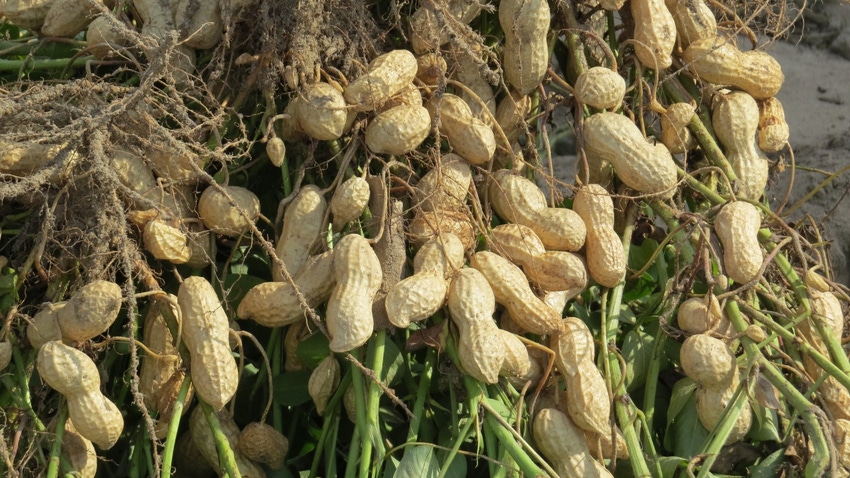
The year 2017 was a very productive one for peanut growers in South Carolina and the rest of the United States. But was it too productive?
South Carolina peanut growers at the 39th annual South Carolina Peanut Growers’ Meeting were told production in the United States for 2017 is estimated to be beyond expected domestic and export demand. This excess supply may have helped put the U.S. peanut market in a holding pattern.
Dr. Nathan Smith, Clemson Extension economist and professor at the Clemson Sandhill Research and Education Center, said South Carolina peanut farmers had a productive year.
“Total acres planted was 122,000 acres, which was a record,” Smith said. “In addition, we also had a record yield. According to the National Agriculture Statistics Service, or NASS, the yield was reported at two tons, or 4,000 pounds per acre. So farmers enjoyed a good year – yields and prices were up.”
That 19 percent increase in peanut acreage is one reason peanut production was so high. How much land will be planted with peanuts in 2018 depends on the price of corn and cotton.
“Last year was a good year,” said Dell Cotton, manager of the Peanut Growers Cooperative Marketing Association. “We’ve had a great yield nationwide for the past two years. This has created an excess stock of peanuts. But the domestic food demand for peanuts is forecast up and exports are going to be very important as well.”
About 25 percent of peanuts grown in the United States are shipped to Canada and Mexico, and China is a major importer of U.S. peanuts.
“We cannot afford to lose any of these markets. China is a very important market to us. Make sure you tell our leaders how important trade is to our profession,” Dell said.
Smith and Cotton agreed that exports will be key in 2018.
“We’ve got strong demand for peanuts, but the key will be exports,” Smith said. “The large crop is going to add to the stock we already have. We need to increase exports or reduce some makers in peanuts for 2018.”
“The competition for land and contract prices will help farmers decide what to plant,” Cotton said.
On Jan. 12, the price of cotton was 80 cents per pound, up 12.7 percent from Dec. 12, 2017. That price was 11.8 percent higher than Jan. 12, 2017. Corn prices increased marginally on the back of solid ethanol production figures in December. But a report released Jan. 12 by the United States Department of Agriculture which revised global stocks and production estimates showing an increase for 2017/2018 caused corn prices to lose some momentum. Corn traded at $3.22 per bushel on Jan. 12, up 1.6 percent from Dec. 12, 2017. It was down 5.9 percent from Jan. 12, 2017. Greater demand for food, feed and industrial uses are expected to cause corn prices to increase.
The latest peanut prices, released by the USDA on Jan. 31 were $424.32 per ton for runner peanuts, $413.60 per ton for Spanish peanuts, $430.46 per ton for Valencia peanuts and $430.46 per ton for Virginia peanuts. In 2017, South Carolina peanut acreage was approximately 60 percent runner and 40 percent Virginia peanuts.
Going in to the 2018 season, Smith advises growers to make sure they have a place to store their crops as well as consider a few items when determining their budgets.
“After four consecutive years of decreases, fuel prices are increasing,” Smith said. “We’re also seeing an increase in seed prices, as well as chemicals used on farms. You’ll want to keep this in mind as you plan.”
Smith said Enterprise Budgets for peanuts will soon be available from the Clemson Extension Service.
The Clemson Extension Service also provides a Peanut Money Maker 2018 Production Guide with information about varieties, crop rotation, tillage, planting, fertility, management of pests and more specifically for South Carolina growers. Dan Anco, peanut specialist housed at Clemson’s Edisto Research and Education Center, said the guide is something peanut growers can use as a quick reference as the season progresses.
“This guide provides a step-by-step ‘game plan’ for peanut production under South Carolina conditions,” Anco said. “Producers can use this (guide) as a reference for some of the questions they may have about peanut production.”
Hugh Weathers, South Carolina commissioner of agriculture, said peanuts are vital to the state’s agribusiness economy.
“South Carolina is one of the nation’s largest peanut-producing states,” Weathers said. “The peanut industry is very important to the South Carolina economy and we are dedicated to helping you continue to produce a high-quality crop.”
About the Author(s)
You May Also Like






